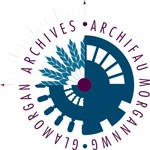Given the part that coal played in the lives of communities across South Wales it is perhaps not surprising that the collection of photographs taken by Edwin Miles and held at Glamorgan Archives, includes several of collieries. The photograph, below, is of Meiros Colliery in Llanharan and it was probably taken in the 1920s.

As with most of the Miles collection there is little by way of background information. However, Glamorgan Archives has a wide range of resources that tell the story of local collieries and the mining communities in South Wales. The National Coal Board Records held at the Archives have basic information on just about every colliery. The information sheet on Meiros confirms that the mine operated for just over fifty years from 1880 to 1931. At its height, in 1923, it employed 750 men working the Pentre seam for coal used primarily for gas-making and coke ovens.
As with coal, you occasionally find a rich seam in the records at the Archives. Meiros Colliery was part owned for much of the time by Francis Andrews. Francis was the son of Solomon Andrews, who had extensive business interests in Cardiff and South Wales, and the records for Solomon Andrews and Son are held at the Archives. They include a number of glorious photographs of Meiros Colliery along with business papers and annual reports detailing the performance of the colliery. The photographs were probably taken around 1918, at a time when the pit was producing almost a quarter of a million tons of coal each year and making a significant profit.

Inevitably, Meiros also had its share of mining disasters. The records include a report of six men sent down at the end of the day shift to deal with a suspected pocket of gas. Sadly there was an explosion and one of the men was killed and the others were badly burned. Such were the stark realities of life in the pits at that time, it was judged that the explosion had not significantly damaged the pit and the night shift went down that evening as planned.
With an economic recession following the war, the 1920s were difficult times for the coal industry. In the latter part of the decade the pit made a loss most years and was eventually closed in 1931. One of the last entries in the Andrews records is a copy of the brochure produced for the sale of the colliery equipment that included two magnificent six wheel, main line gauge locomotives.

The photograph of Meiros Colliery taken by Edwin Miles can be found under reference D261/M774. The NCB information sheets referred to can be found at DNCB/5/2. The photographs taken from the Andrews papers are at DAB/34/25 and DAB/25/4/78.
If you are interested in the history of the coal industry and local communities in South Wales you can access a research guide, “Colliery Records for Family Historians”, on the website of Glamorgan Archives. You may also wish to visit the Glamorgan’s Blood exhibition. Dates and venues for the exhibition, compiled using the NCB records, can be found on the Glamorgan Archives website under the “What’s On” heading.
We plan to feature more photographs from the Edwin Miles collection over the coming months. The main collection can be seen at Glamorgan Archives or online in the catalogue at http://calmview.cardiff.gov.uk/ under reference D261.
Tony Peters, Glamorgan Archives Volunteer










